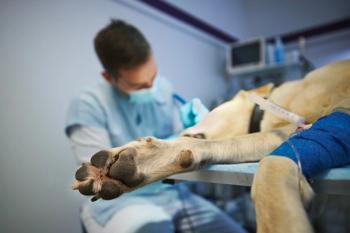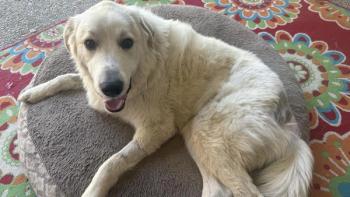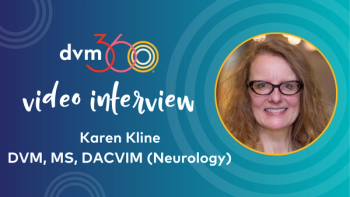
Hearing loss in veterinary equine patients
An overview of the conditions associated with auditory problems in foals and adult horses.
Paint horses with blue eyes are more likely to experience genetic deafness than other types of horses (GETTY IMAGES/John Pitcher).Although deafness in horses is relatively rare, equine practitioners who do see signs of deafness in their patients can find the underlying condition challenging to diagnose. However, collecting a thorough history and discussing behavioral and temperament changes with clients can help veterinarians help their patients with complete or partial deafness-in most cases providing a good outcome and a favorable performance outlook.
Reported causes of deafness in horses include trauma, inflammation or infection of the peripheral auditory pathways (for example, temporohyoid osteoarthropathy [THO] and otitis externa or media), and suspected gentamycin intoxication.1 The failure of sound waves to be conducted from the ear canal to the inner ear is referred to as conductive deafness, while alterations of the neural structures in the auditory pathway result in sensorineural deafness, says Monica Aleman, DVM, DACVIM, of the University of California, Davis, School of Veterinary Medicine.2
The presenting complaint with these horses and their owners varies according to the disease present. Common client observations include altered behavior, such as startling in response to environmental stimuli, and training difficulties, such as lack of response to verbal cues. Other signs, such as leaning to one side, head tilt, head shaking, undefined gait deficits, corneal ulceration and dysphagia, have also been reported.2
Physical and neurologic examination often reveals clinical signs commonly associated with hearing loss, Aleman notes. These signs include startling when approached and not turning the head or ears toward the source of a loud noise. In cases of concurrent conditions, such as brain disease, multiple cranial nerve deficits (mastication deficits with or without masticatory muscle atrophy, facial paresis or paralysis with or without vestibular disease or alterations in alertness) are often noted.
Head shaking and ear rubbing are associated with ear infections. Horses with THO can present with vestibular disease, displaying signs such as head tilt, nystagmus, positional strabismus (abnormal eyeball position upon movement of the head), leaning to one side and ataxia.2
Although genetic deafness is most common in Paint horses, any horse with a lot of white or diluted color in its coat can be deaf due to a genetic link between deafness and coat and eye color, Aleman says. A horse can also become deaf after experiencing head trauma. “In thoroughbreds, one of the most common causes of deafness is trauma in the stall or the gate,” she says. “If a thoroughbred becomes fractious and has an accident that affects its head or brain, it can lose its hearing.”
BAER testing
Although behavioral signs can suggest deafness, the definitive test to determine the presence and extent of deafness is brainstem auditory evoked response (BAER). BAER testing evaluates the integrity of the auditory pathway.
The normal BAER test consists of a sequence of five to seven peaks (representing depolarization of neural structures along the auditory pathway), named I to VII, which occur during the first 10 milliseconds after stimulus onset.2
BAER is a noninvasive, safe, inexpensive way to gain diagnostic information. It requires minimal restraint (standing sedation) and provides objective information about the functional status of the auditory system.3
General equine practitioners have a number of referral options for facilities with BAER equipment. “Many veterinary schools have BAER equipment in their neurology departments,” says K. Gary Magdesian, DVM, professor of medicine and epidemiology at the UC Davis veterinary school. “Some small animal neurology practices would have these also.”
Auditory loss in foals
Here are several conditions that can be associated with auditory loss in foals.
Congenital malformations. These are bony deformations of the skull that cause auditory loss. “We don't see the condition commonly, but we do see it once in a while, especially in miniature horses,” Aleman says. “It may be that since they're of such small size-even more so when born-their skulls are thick. And some are born with no acoustic canals. It's uncommon, but it does happen.”
Lavender foal syndrome. This is a genetic mutation. “I've tested only one of those foals with a BAER,” Aleman says. “I don't know if the deafness was because of the coat color dilution or because that particular foal was also septic. It's possible that it's color-related. We need to look at more affected foals to be more knowledgeable of this condition.”
Overo lethal white foal syndrome (OLWFS). OLWFS involves a lack of melanocytes and links white skin pigment, blue eyes and deafness. Melanocytes, which are critical to proper hearing and cochlear function, are derived from the neural crest and migrate to a section of the cochlea called the stria vascularis.1
Without melanocytes in the inner ear, the stria vascularis doesn't develop or function normally and may degenerate along with cochlear hair cells (neural hearing receptors), leading to hearing loss, according to Magdesian. Congenital deafness is associated with abnormal migration of these melanocytes from the neural crest and poor survival or development in the inner ear of some animals, such as American Paint horses, with alternations in coat pigmentation (white spotting) and iris color (blue eyes).1
Neonatal encephalopathy. One cause of encephalopathy is excess bilirubin, the product of red blood cell (RBC) breakdown. “Bilirubin can be very elevated in foals that have neonatal isoerythrolysis,” Aleman says. In these cases, bilirubin accumulates to toxic levels in the brain. In human infants, high bilirubin levels in the brain can induce permanent brain damage, especially to the hearing portion of the brain. Another encephalopathy is found in foals that suffer from hypoxic injury before, during or after delivery, and the damage can be permanent.
Sensorineural deafness. “These are foals that have a genetic mutation,” Aleman says. “For example, Paint horses can carry a mutation associated with their skin pigmentation. When you have a stallion that carries a mutation and you cross that with a mare with the same mutation, you increase the chances of having a completely white foal with one or two blue eyes and would produce deafness.”
“Sensorineural” means from the neural auditory pathway. An ear infection where the ear canal is plugged with debris is an example of nonneural deafness; the nerve portion of the auditory system is intact. The term “sensorineural deafness” means the nervous part of the auditory system is abnormal-that some part of the nervous portion is affected.
Sensorineural deafness may exist in some splashed white, frame Overo, Tovero and Overo-blend Paint horses, particularly those with large amounts of white on the face and limbs and those with particularly heterochromic or completely blue eyes. In one study, BAER testing confirmed bilateral deafness with complete lack of waveforms in 10 of 10 deaf American Paint horses tested. All of the confirmed and suspected-deaf horses had one or more blue or partially heterochromic irises.1
Hearing deficits in foals appear as complete absence of BAER; this occurs both in neonatal foals with common neonatal disorders (sepsis, neonatal encephalopathy caused by hypoxia, prematurity) and in those with neonatal isoerthrolysis. Congenital or hereditary disorders, such as multiple malformations and particular coat color patterns, can be associated with auditory function impairment.4
Neonatal isoerythrolysis (NI). NI occurs when mares have antibodies against the RBCs of the foals and pass these antibodies via colostrum. The antibodies bind to the RBCs and destroy them, Aleman explains. “When the RBCs are destroyed, a breakdown product, bilirubin, accumulates,” she says. “Bilirubin crosses the blood-brain barrier and accumulates there as well. Bilirubin is quite toxic to the brain and can damage the auditory portion, producing deafness. Foals with NI are at risk of having encephalopathy because of high bilirubin.”
Thus, foals are born with a functional auditory system comparable to that of adult horses when tested at 90 dB HL (hearing level). Brain insults in the perinatal period, such as those associated with sepsis, hypoxic ischemia and marked hyperbilirubinemia, should be considered as potential causes of hearing loss in neonatal foals.4
Prematurity can result in a nonfunctional auditory system similar to that reported in premature infants. Furthermore, neonatal foals are commonly presented with a combination of problems, possibly increasing the risk of hearing impairment. Congenital or inherited disorders, such as those associated with multiple malformations and coat color patterns, also should be considered as potential associations with hearing loss.4
Auditory loss in adult horses
Deafness can be associated with the following conditions in mature horses.
Sensorineural deafness. As in foals, ensorineural deafness may exist in splashed white, frame Overo and Overo-blend Paint horses, particularly those with large patches of white on the face and limbs and those with partially heterochromic or completely blue eyes.1 “A minority of horses with these white spotting patterns are deaf, but it's common enough that veterinarians should be aware of the association,” says Magdesian.
Temporohyoid osteoarthropathy (THO). THO is a disorder of the petrous temporal and stylohyoid bones that form the temporohyoid joint. Presence of neurologic deficits (facial paralysis and vestibular nerve dysfunction) and abnormalities in the temporohyoid apparatus have been strongly associated with BAER abnormalities.3
In one study, all horses with THO that were tested with BAER were found to be deaf as follows: complete unilateral BAER loss (82 percent), partial unilateral BAER loss (18 percent) on the most affected side, and contralateral partial BAER loss (46 percent).3
Absence of identifiable BAER peaks was most compatible with complete hearing loss. Increased peak latencies, difficulty in identifying peaks, or both were suggestive of partial hearing loss. Most horses with THO in this study had a complete absence of waveforms, which is most consistent with peripheral sensorineural hearing loss; however, severe conduction disturbances could not be ruled out.3
Auditory abnormalities, such as a completely or partially abnormal BAER, are common in horses with THO.3 The proposed etiologies of THO hearing loss in horses include inflammation, infection of the middle ear (otitis media interna) secondary to a hematogenous or an ascending infection from the upper respiratory tract, guttural pouches or both, extension of otitis externa, and a nonseptic primary degenerative process that results in arthrosis of the temporohyoid joint.4
With THO, owners might notice some eye involvement, though eye damage is not related to deafness per se. “When horses have THO, one sign that horse owners sometimes notice is corneal ulceration,” says Aleman. “This is actually secondary to dysfunction of another cranial nerve, seven. Eye involvement has nothing to do with the hearing or hearing loss, only that horses with THO have damage to nerves seven (facial) and eight (vestibulocochlear).”
In conclusion, auditory abnormalities are common in horses with THO. Diseased horses appear to have peripheral sensorineural hearing loss that may be complete or partial, and in some cases of bilateral THO, the horses also have contralateral partial hearing loss.3
Training and safety issues
With deaf horses, trainers have to modify their approach so that the horse responds properly, Aleman says. “If the horse has acquired deafness and is already trained, it probably will be easier to adapt to the new situation of being deaf,” she says. “Horses that are deaf or become deaf are definitely trainable; they just need specific care to adjust to their deafness.”
Magdesian states that many trainers and riders aren't aware of their horse's deafness, which can lead to problems if they assume the horse is not responding to auditory cues. With trainer or rider awareness and the use of visual (when doing ground work like lunging) and tactile cues (when driving or riding), deaf horses perform normally and as well as hearing horses.
Aleman notes that with deaf horses, “we just have to be a little more careful. They can startle easier. The newly deaf horse can adapt to its situation. It's not that they're going to be completely dangerous and unmanageable. They just require some special training, and we should avoid whenever possible unfamiliar situations and environments.” Handlers should approach horses from a position where they can be seen, which is easily done in horses as their visual field is so wide and has little in the way of blind spots, says Magdesian.
Summary
Other than the results of a BAER test, which are definitive, there are other signs of deafness a practitioner can look for. “When doing an examination on the horse, something very simple can be tried-clap loudly, hiding the action, so the horse doesn't witness it,” Aleman suggests. “It will either hear or not hear the noise.”
After making a loud sound, look for the horse to turn its ears, adjusting its attention to respond to the sound, possibly moving away. If the horse reacts to the sound, one can assume the horse hears. If not, suspect the animal to be deaf or partially deaf, maybe in only one ear.
Determining whether a horse is partially deaf can be difficult. That's where the BAER test is vital and can easily discern partial deafness. If the horse can hear from one ear, it may respond to the sound but won't be able to localize it. For example, if you're standing on the right side of the horse and it has hearing on that side, either it will move away from you because it knows the sound is coming from that direction, or it's going to turn toward you because it knows where the sound is coming from. A horse needs both ears intact to properly localize sound.
Although a horse may be deaf and therefore have some quirks in its behavior because of its deafness, it shouldn't become a major concern. However, owners need to be cognizant of the deafness, handle their animal carefully and tailor training to its specific needs.
References
1. Magdesian KG, Williams DC, Aleman M, et al. Evaluation of deafness in American Paint Horses by phenotype, brainstem auditory-evoked responses, and endothelin receptor B genotype. J Am Vet Med Assoc 2009;235(10):1204-1211.
2. Aleman M, Holliday TA, Nieto JE, et al. Brainstem auditory evoked responses in an equine patient population: part I-adult horses. J Vet Intern Med 2014;28(4):1310-1317.
3. Aleman M, Puchalski SM, Williams DC, et al. Brainstem auditory-evoked responses in horses with temporohyoid osteoarthropathy. J Vet Intern Med 2008;22(5):1196-1202.
4. Aleman M, Madigan JE, Williams DC, et al. Brainstem auditory evoked responses in an equine patient population: part II-foals. J Vet Intern Med 2014(4);28:1318-1324.
Suggested reading
• Wilson WJ, Mills PC, Dzulkarnain AA. Use of BAER to identify loss of auditory function in older horses. Aust Vet J 2011;89(3):73-76.
• Marshall AE, Byars TD, Whitlock RH, et al. Brainstem auditory evoked response in the diagnosis of inner ear injury in the horse. J Am Vet Med Assoc 1981;178(3):282-286.
Ed Kane, PhD, is a researcher and consultant in animal nutrition. He is an author and editor on nutrition, physiology and veterinary medicine with a background in horses, pets and livestock. Kane is based in Seattle.
Newsletter
From exam room tips to practice management insights, get trusted veterinary news delivered straight to your inbox—subscribe to dvm360.






